
Back |
Ecuador:
Running my first station |

Next |
|
|
My first business card as owner of a radio station. "Director"
was a more common term than "General Manager" and indicated, of
course, ownership as well.
When Radio
Musical went on the air, there were nearly 40 other AM stations
in this market of 700,000. |
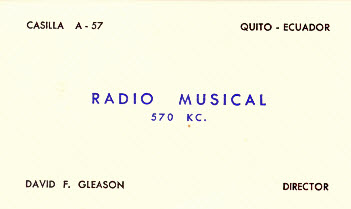 |
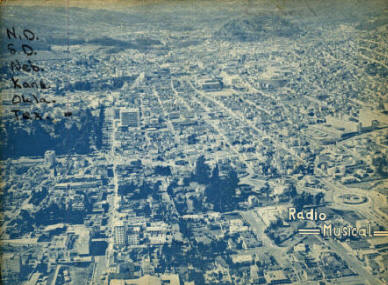 |
This was
the cover of the original sales presentation for Radio
Musical... Quito stations did not have such things in 1964 and
all rate cards were verbal! (and rates, were, shall we say,
fluid.) HCRM1 had
the highest rates in the market... and a commercial limit of 10
minutes an hour at a time when 30 minutes was common. Click
HERE
to see a list of all the
competitors in 1964!
To serve this market, Radio
Musical went on the air the 5th of December of 1964. It had no
commercials to air on its first day... just music. |
|
Radio
Musical was a daring venture in retrospect. Against over 30
competitors, all with block programming, appeared the first Top
40 station in South America. Advertisers thought it was a
ridiculous proposition, as they were used to sponsorable block
programs, not a 24-hour music format. No one advertised. Our
first client didn't pay his bill... (I learned that it is not a
sale unless it pays.) A competitor referred to us as the "pocket
station" as only kids with pocket transistor radios listened.
Anyone with more experience in Ecuadorian radio would not have
done this crazy project.
By the sixth month, HCRM was only billing about $50
a month. |
|
We were a month away from
bankruptcy.
In June, a box arrived from Guayaquil, the
major ad center for Ecuador. It was from McCann-Erickson, and
had orders and acetate commercial disks for every radio account
they had, and for 15 to 20 spots a day each! McCann had done a
survey. The little new station was #1. Within weeks, we were
sold out.The station was under such demand that by the end of
1965, clients could only by Run-of-Schedule spots and a quarter
of the schedule ran between midnight and 6 AM. In the Datos
surveys, it was frequent to see the evening hours with shares in
excess of 75% of listening; the hours after 10PM came close to
100%. |
|
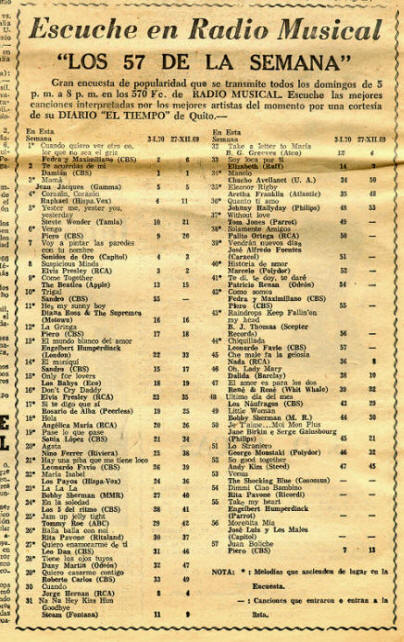 |
A "57 of the Week" from the late 60's.
Click
on the chart to see a more readable PDF version.
As
befitting a Top-40 station, Radio Musical had its "57 of the
Week" and the list of the city's most popular songs was
published every Sunday by the Diario El Tiempo in Quito, and the
entire hit parade was counted down at 5 PM! (The #1 song was by
Argentine duo Fedra & Maximiliano, and the #8 ranker was
"Suspicious Minds" by Elvis Presley.
Radio Musical
played the hits no matter the language... there were many French
and Italian songs on the list as well, and we made an annual
trip to the San Remo Festival in Italy to bring back the
competing songs which always found great acceptance (and was
sponsored by Ing. Luigi Perotti, the importer of Borletti sewing
machines).
|
|
Radio Musical
played lots of hits from the US; of course, they were not
available in Quito anywhere. So my mother, in Cleveland, each and every week
of the year, went to a record distributor in Cleveland and sent
the new songs that had just debuted on the WIXY chart! A few
days later, the same songs were heard on Channel 57 in Quito, to
the obvious delight of our listeners |
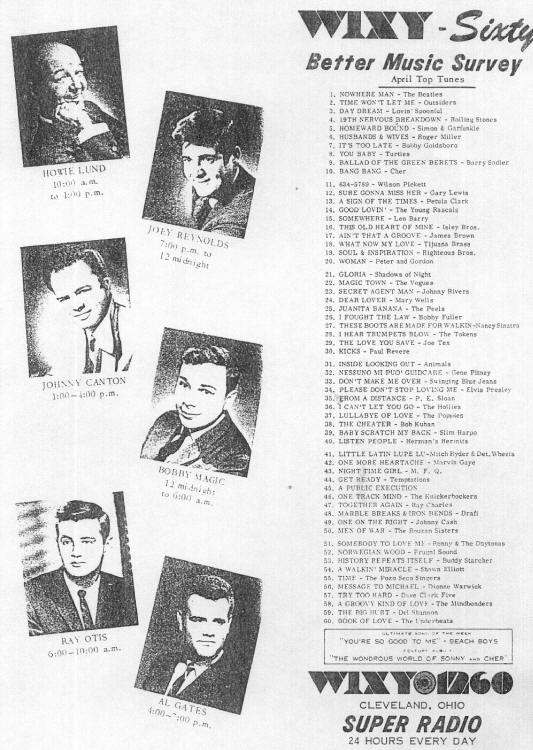 |
|
 |
"Official
letter of Verification" sent to a listener in Texas who received
Canal Tropical in its first year of broadcasting.
Note that by late 1966 there were 6 sets of call letters for
the group. Click on the letter for a more readable PDF version
of the letter.
|
|
From the
International Radio Club of America's DX Monitor from December
of 1964 comes my DX report as well as the report of noted Denver
area DXer Larry Godwin who visited my station while touring
South America by Jeep!
Click the scan above for a
better quality PDF of the page.
|
 |
| |
|
|
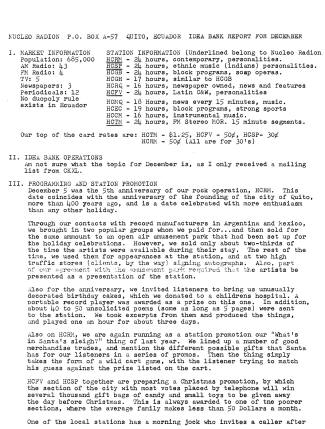 |
In the pre-fax, pre-Internet
world, several groups of independent radio stations
were formed to exchange ideas through private
newletters. One group was the International
Broadcasters Idea Bank, a group of 100 stations in
the US, Canada and australia. I joined as the only
Latin American member in 1965. One of the
newsletters I sent is at the left. Click on it to
read the whole report which describes sales,
promotion and other activities of my stations. |
|
|
In an article in the Quito daily
paper "Hoy" Francisco Febres Cordero writes about La
Mariscal, the traditional upscale neighborhood of Quito where Radio
Musical and its sister stations were located. In the article, he
shows how much Radio Musical was a part of the culture and history
of Quito in the late 60's. |
|
"Muchos años
después -desplazados que fueron los caballos a
sectores ignotos- los autos continuaron
simbolizando en La Mariscal el paso de la niñez
a la adolescencia: los "hijitos de papá"
paseaban por la avenida Amazonas en un incesante
tránsito circular de todas las tardes a la
salida del colegio y todo el fin de semana, sin
otra misión que la de ser vistos por la
parroquia y la de admirar a las quinceañeras
que, a su vez, cruzaban en sentido contrario una
vez tras otra vez tras otra vez, al ritmo de las
melodías de Enrique Guzmán o Alberto Vásquez,
que Gabriel Espinosa de los Monteros o Pepe
Rosenfeld hacían sonar en la consola de Radio
Musical. A través de una de las ventanas de esa
casa, identificada con el número 1027, se
dejaban ver los primeros disck jockey de la
radiodifusión, para recibir, con sonrisa
conquistadora, el saludo de sus fans. |
"Many years later, the horses
having been removed to more remote areas, cars continued to
symbolize in La Mariscal the passage from childhood to
adolescence. The rich kids drove back and forth along
Amazonas Avenue every afternoon after school and every weekend
with no other goal than that of being seen and admiring the
young ladies, who followed the same circular route in the
opposite direction to the beat of the songs of Enrique Guzmán or
Alberto Vázquez that Gabriel Espinosa de los Monteros and Pepe
Rosenfeld played at the console of Radio Musical. From the one
of the windows of that building, identified with the number
1027, you could see the first disk jockeys of (Quito) radio, who
were ready to acknowledge with a winning smile the waves of
their fans." |
|
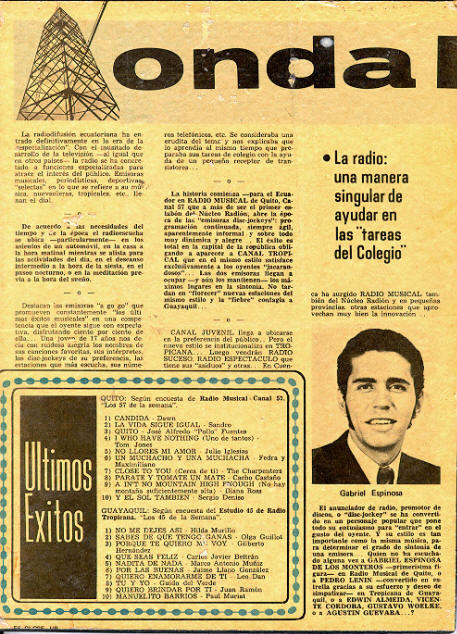 |
A
local magazine features the Radio Musical chart and night jock
Gabriel Espinosa de los Monteros.
The text reads:
"History,
for Ecuador, begins at Radio Musical in Quito, which, in
addition to being the first link in the Núcleo Radión (group)
opens the era of "disk jockey stations." Non-stop programming,
always agile, obviously informal, but always dynamic and happy.
Success is total in the Capital of the Republic, making
it necessary for Canal Tropical to soon appear, satisfying dance
music fans with the same style of radio. Both stations reach,
and still hold, the highest positions in the ratings."
No greater
compliment have I ever been paid. I was just 20 at the time. |
|